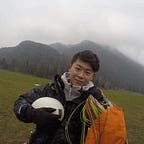Team: Binru Liu & Yitong Han
We first developed the functional framework of the APP and then created an information structure diagram. The APP has four main functions: Making travel plans (Individual or Group), Managing travel plans, The friends system and The message system. The core functions of the APP are making travel plans and the message system.
Core functions introduction
We have made the process of making travel plans gamified. In this prototype, the function of collaborative travel planning is turned into a form of a puzzle. Considering the users’ needs, we should give them an opportunity to be involved in the whole trip planning process. Each team member can participate in any part of the planning process and express his opinion. When the travel puzzle is complete, the system will consider the needs of everyone and automatically produce some travel itineraries to suit everyone. Users can also edit these itineraries themselves.
This puzzle function has been achieved in the second prototype (Planning Toolkit — Online). Users liked the feature and wanted us to improve the visual appearance of the puzzle.
The role of the message system is to provide users with all the information they may need in time, such as travel restrictions policies, traffic conditions, weather conditions and changes in the opening hours of tourist attractions. This information supports the users to resolve unexpected situations. In the last user testing, middle-aged and elderly users felt that the message system was necessary for them because some of them are not very good at finding solutions by themselves.
APP Introduction
Our final product is a travel APP called Travel Puzzle. Besides the two core functions just described, the APP also has a social component. Users can meet new friends and potential travel companions through the APP.
The APP also has the “ Explore “ function. When a user is looking for a travel destination, he can use the explore function to see the travel notes and photos posted by other users. Other people’s notes are valuable for travellers. Users can also share their travel notes and photos through the “Explore” function. Their travel notes may help other users.
User testing
We invited several users of different ages to use our app, and we found that they have different concerns. Younger users are more concerned about the efficiency of the product, they want the product to meet their requirements quickly. Older users are more concerned with the visual and reading experience of interfaces.
Feedback and Reflection
We have received much useful feedback from user testing and we will iterate on our APP prototype based on this feedback. Users thought the APP prototype was easy to use. They can plan their trips whenever and wherever they want. However, the prototype still needs to be improved. Firstly, the visual design of the UI needs to be improved. Some users felt that the current colour scheme of the interface was not very good and that it affected the reading experience. Secondly, the variety of information in the main page is not very useful.
When the target user group is more than one, designers should focus more on the usability and inclusiveness of the product. I have used Nielsen’s usability theory in the process of my work and have received positive user feedback. In our APP, we allow users to go back to their previous action. This design allows users to quickly fix their mistakes. As Nielsen (2005) states, users have the freedom to use and control the system.
Now, we are ready to iterate on our APP based on user feedback. We will read more literature and improve the user experience of the app.
Reference
Nielsen, J. (2005) Ten usability heuristics.
